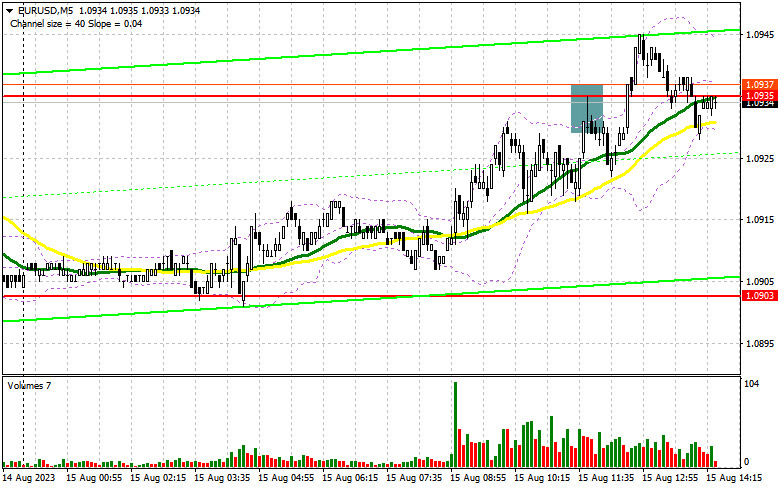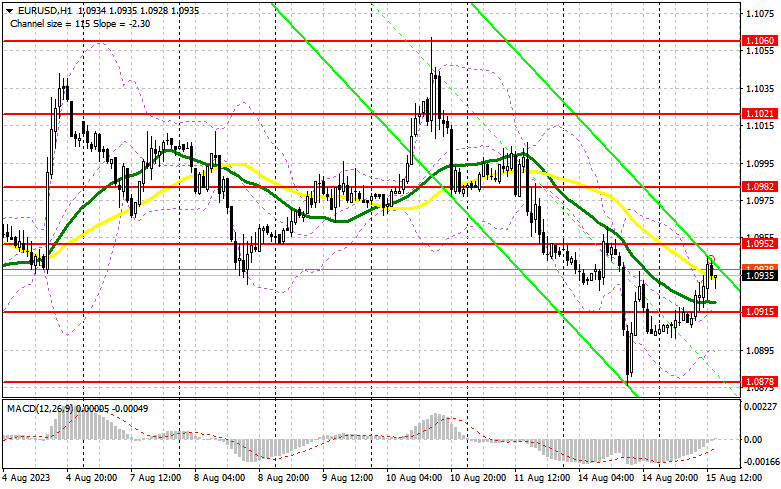
In my morning forecast, I drew attention to the level of 1.0935 and recommended making decisions about entering the market based on it. Let's look at the 5-minute chart and figure out what happened there. The growth and formation of a false breakout at this level provided an excellent sell signal. However, there was no significant downward movement because the statistics for Germany and the Eurozone were acceptable. The technical picture was fully reviewed for the second half of the day.

To open long positions on EURUSD, it is necessary:
In the second half of the day, important data on US retail sales is expected. Growth above economists' forecasts will pressure the pair, leading to yesterday's scenario when the euro fell sharply against the US dollar. However, if the figures turn out to be worse than economists' forecasts, indicating a likely further slowdown in inflation mixed with lower GDP growth rates, pressure will increase on the US dollar, prompting the rise of EUR/USD. Of course, I would like to see a decrease in the pair in the second half of the day and the defense of the new support at 1.0915, formed during the European session. The moving averages also pass, playing on the side of the bulls. The formation of a false breakout at 1.0915 will provide a good entry point for purchase in continuation of the development of the upward correction to update the resistance at 1.0952. A breakthrough and top-down test of this range will strengthen the demand for the euro, giving a chance to continue the upward trend and update the maximum at 1.0982. The ultimate target remains the area of 1.1021, where I will fix the profit.
In the case of a decrease in EUR/USD and the absence of activity at 1.0915 in the second half of the day, which is quite possible after strong data from the US, pressure on the pair will return. In such a case, only the formation of a false breakout in the area of the next support at 1.0878 – the minimum of this week, will give a signal to buy the Euro. I will open long positions immediately on the rebound from 1.0836 with the aim of an upward correction of 30-35 points within the day.
To open short positions on EURUSD, it is necessary:
Sellers are counting on good US retail sales figures, supporting the bearish trend and bringing pressure back on the pair. I will act only after the rise and formation of a false breakout in the area of the nearest resistance at 1.0952, which will lead to a sell signal and a drop in the pair to support at 1.0915, formed in the first half of the day. Only after the breakout and consolidation below this range, as well as the reverse test from the bottom up, can you get a sell signal, opening the way to a minimum of 1.0878. The ultimate target will be the area of 1.0836, which will indicate the establishment of a bearish trend. There I will fix the profit. In case of an upward movement of the EUR/USD during the American session and the absence of bears at 1.0952, which cannot be ruled out, the bulls will try to re-enter the market. In such a scenario, I will postpone short positions until the next resistance at 1.0982. There you can also sell, but only after unsuccessful consolidation. I will open short positions immediately on the rebound from the maximum of 1.1021 with the aim of a downward correction of 30-35 points.

Indicator signals:
Moving averages:
Trading is conducted around the 30 and 50-day moving averages, indicating market uncertainty.
Note: The author considers the period and prices of the moving averages on the hourly chart H1 and differ from the general definition of classic daily moving averages on the daily chart D1.
Bollinger Bands:
In case of an increase, the upper border of the indicator will act as resistance in the area of 1.0895.
Description of indicators:
• Moving average (determines the current trend by smoothing out volatility and noise). Period 50. Marked in yellow on the chart.
• Moving average (determines the current trend by smoothing out volatility and noise). Period 30. Marked in green on the chart.
• MACD Indicator (Moving Average Convergence/Divergence - convergence/divergence of moving averages) Fast EMA period 12. Slow EMA period 26. SMA period 9.
• Bollinger Bands. Period 20.
• Non-commercial traders - speculators, such as individual traders, hedge funds, and large institutions that use the futures market for speculative purposes and meet certain requirements.
• Long non-commercial positions represent the total long open position of non-commercial traders.
• Short non-commercial positions represent the total short open position of non-commercial traders.
• The total non-commercial net position is the difference between the short and long positions of non-commercial traders.